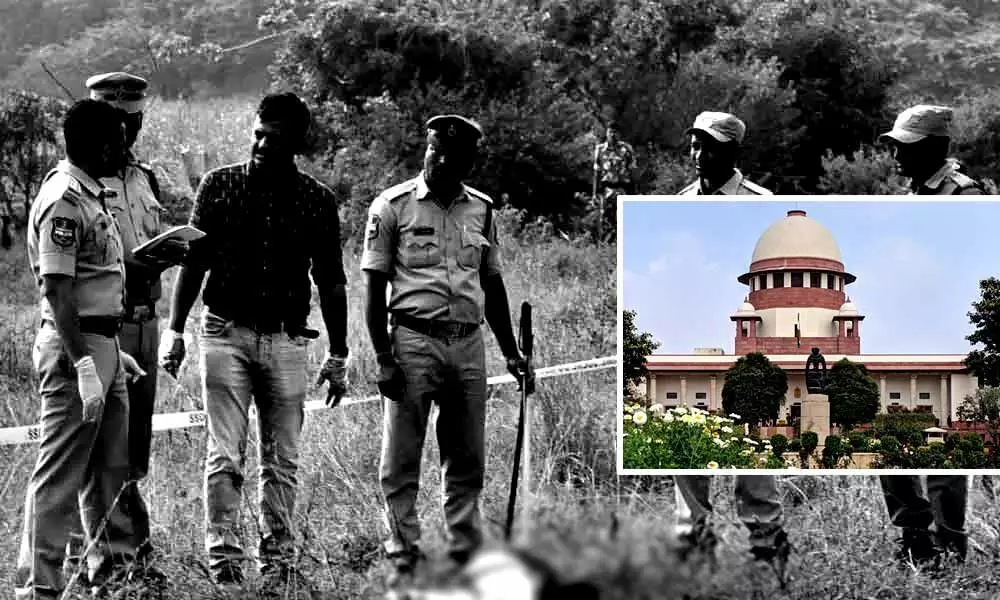A gangster’s son turned politician and his assistant were slain in an encounter in Uttar Pradesh.

Why are we debating this?
- The National Human Rights Commission (NHRC) and the Supreme Court have established suitable standards and processes to be followed in order to prevent law enforcement forces from abusing their authority.
- However, this encounter has brought to light the subject of extra-judicial executions or “encounters” by Indian police.
Supreme Court Encounters Guidelines
- A bench comprised of then-CJI RM Lodha and Rohinton Fali Nariman gave comprehensive directions in September 2014.
- These rules were issued as a result of the lawsuit “People’s Union for Civil Liberties v. State of Maharashtra.”
- The recommendations outlined 16 factors to consider when examining police contacts in situations of death as the normal approach for conducting a complete, effective, and independent investigation.-
- Registration of a first information report (FIR) as mandatory
- Inquiry by a magistrate Keeping written records of intelligence inputs
- Independent investigations by organisations such as the CID
- In all incidents of death resulting from police intervention, a Magisterial Inquiry must invariably be held.
- The deceased’s next of kin must invariably be included in such an investigation.
- When a complaint is filed against the police alleging that they committed a criminal act that constitutes a cognizable case of culpable homicide, a FIR must be filed under the appropriate provisions of the IPC.
- According to Section 176 of the Code of Criminal Procedure, 1973, an investigation must decide “whether the use of force was justified and the action taken was lawful.”
- Whenever the police get information or a tip-off about criminal movements or activities related to the conduct of a serious crime, “it shall be reduced into writing in some form (preferably in a case diary) or in some electronic form.”
- Following such a tip-off or intelligence, if a confrontation occurs and a firearm is used by the police party, resulting in death, a FIR must be recorded and delivered to the court under Section 157 as soon as possible.
Provisions for a separate investigation into the incident
- The requirements/norms must be scrupulously followed in all situations of death and serious injury in police encounters, as stipulated in Article 141 of the Indian Constitution.
- The Supreme Court’s decision will be binding on all other courts in Indian Territory.
- “Unless there is serious doubt about independent and impartial investigation,” the NHRC’s intervention is not required.
- The incident must be reported to the NHRC or the State Human Rights Commission.
NHRC Encounter Guidelines
- The National Human Rights Commission (NHRC) has advised all states and union territories to adopt a set of recommendations in circumstances where police confrontations result in death.
- These included the police’s obligation to put any information received concerning encounter deaths into a “appropriate register,” as well as procedures for independent investigations by institutions such as the State CID.
Issues with such encounters
- This practise jeopardises the rule of law, due process, the right to life, and other human rights.
- Excessive force has been accused of being used by police and security agencies.
- Fake encounters: There have been reports of encounters being planned and carried out in order to eliminate suspects without going through the normal legal channels.
- Concerns have been raised about impunity and a lack of accountability, as well as the need for reforms to ensure that law enforcement officers are held accountable for their actions.
- Mistrust of the general public: The general people regularly loses faith in the constitutional process of justice.
Why are such encounters popular among public?
- Lack of faith in the legal system: Some people may see extrajudicial killings and encounters as a method to avoid the legal system, which they may perceive to be corrupt or incompetent.
- Perception of safety: Some members of the public may believe that such interactions can dissuade criminals and make their neighbourhoods safer.
- Frustration with the sluggish pace of justice: The Indian legal system may be long and drawn out, and some individuals may see extrajudicial killings and encounters as a way to speed up the justice process.
- Human rights ignorance: Some people may be unaware of the human rights implications of such encounters, or they may regard them as a necessary means to an end.
@the end
- Extrajudicial killings and confrontations, on the other hand, are illegal, undermine the rule of law, and violate human rights.
- They also involve the possibility of abuse and can result in the targeting or killing of innocent persons.
- As a result, in a democratic and law-abiding community, such practises cannot be justified or supported.
Source: https://www.thehindu.com/news/national/explained-police-encounters-in-india-cases-conviction-court-orders/article65463140.ece
